Jonathan Tremblay
3D-Generalist: Self-Improving Vision-Language-Action Models for Crafting 3D Worlds
Jul 09, 2025Abstract:Despite large-scale pretraining endowing models with language and vision reasoning capabilities, improving their spatial reasoning capability remains challenging due to the lack of data grounded in the 3D world. While it is possible for humans to manually create immersive and interactive worlds through 3D graphics, as seen in applications such as VR, gaming, and robotics, this process remains highly labor-intensive. In this paper, we propose a scalable method for generating high-quality 3D environments that can serve as training data for foundation models. We recast 3D environment building as a sequential decision-making problem, employing Vision-Language-Models (VLMs) as policies that output actions to jointly craft a 3D environment's layout, materials, lighting, and assets. Our proposed framework, 3D-Generalist, trains VLMs to generate more prompt-aligned 3D environments via self-improvement fine-tuning. We demonstrate the effectiveness of 3D-Generalist and the proposed training strategy in generating simulation-ready 3D environments. Furthermore, we demonstrate its quality and scalability in synthetic data generation by pretraining a vision foundation model on the generated data. After fine-tuning the pre-trained model on downstream tasks, we show that it surpasses models pre-trained on meticulously human-crafted synthetic data and approaches results achieved with real data orders of magnitude larger.
BOP Challenge 2024 on Model-Based and Model-Free 6D Object Pose Estimation
Apr 03, 2025Abstract:We present the evaluation methodology, datasets and results of the BOP Challenge 2024, the sixth in a series of public competitions organized to capture the state of the art in 6D object pose estimation and related tasks. In 2024, our goal was to transition BOP from lab-like setups to real-world scenarios. First, we introduced new model-free tasks, where no 3D object models are available and methods need to onboard objects just from provided reference videos. Second, we defined a new, more practical 6D object detection task where identities of objects visible in a test image are not provided as input. Third, we introduced new BOP-H3 datasets recorded with high-resolution sensors and AR/VR headsets, closely resembling real-world scenarios. BOP-H3 include 3D models and onboarding videos to support both model-based and model-free tasks. Participants competed on seven challenge tracks, each defined by a task, object onboarding setup, and dataset group. Notably, the best 2024 method for model-based 6D localization of unseen objects (FreeZeV2.1) achieves 22% higher accuracy on BOP-Classic-Core than the best 2023 method (GenFlow), and is only 4% behind the best 2023 method for seen objects (GPose2023) although being significantly slower (24.9 vs 2.7s per image). A more practical 2024 method for this task is Co-op which takes only 0.8s per image and is 25X faster and 13% more accurate than GenFlow. Methods have a similar ranking on 6D detection as on 6D localization but higher run time. On model-based 2D detection of unseen objects, the best 2024 method (MUSE) achieves 21% relative improvement compared to the best 2023 method (CNOS). However, the 2D detection accuracy for unseen objects is still noticealy (-53%) behind the accuracy for seen objects (GDet2023). The online evaluation system stays open and is available at http://bop.felk.cvut.cz/
RoboSpatial: Teaching Spatial Understanding to 2D and 3D Vision-Language Models for Robotics
Nov 25, 2024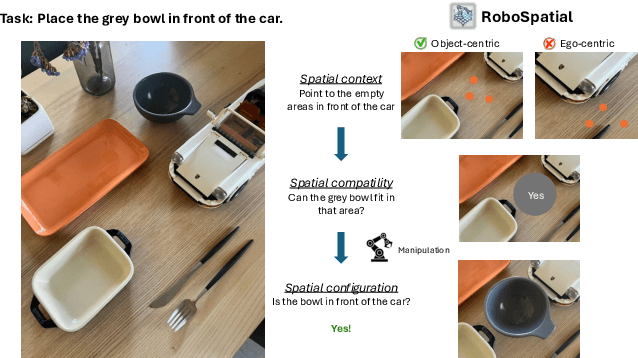

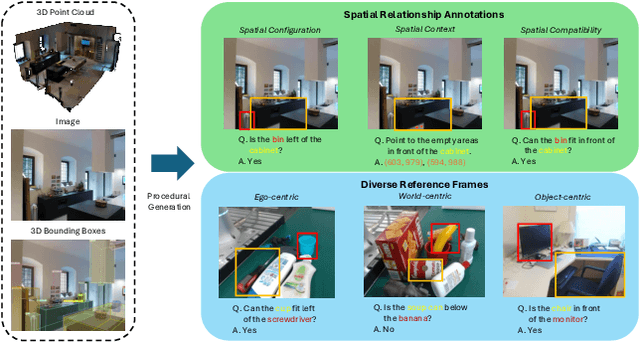

Abstract:Spatial understanding is a crucial capability for robots to make grounded decisions based on their environment. This foundational skill enables robots not only to perceive their surroundings but also to reason about and interact meaningfully within the world. In modern robotics, these capabilities are taken on by visual language models, and they face significant challenges when applied to spatial reasoning context due to their training data sources. These sources utilize general-purpose image datasets, and they often lack sophisticated spatial scene understanding capabilities. For example, the datasets do not address reference frame comprehension - spatial relationships require clear contextual understanding, whether from an ego-centric, object-centric, or world-centric perspective, which allow for effective real-world interaction. To address this issue, we introduce RoboSpatial, a large-scale spatial understanding dataset consisting of real indoor and tabletop scenes captured as 3D scans and egocentric images, annotated with rich spatial information relevant to robotics. The dataset includes 1M images, 5K 3D scans, and 3M annotated spatial relationships, with paired 2D egocentric images and 3D scans to make it both 2D and 3D ready. Our experiments show that models trained with RoboSpatial outperform baselines on downstream tasks such as spatial affordance prediction, spatial relationship prediction, and robotics manipulation.
Neural Fields in Robotics: A Survey
Oct 26, 2024Abstract:Neural Fields have emerged as a transformative approach for 3D scene representation in computer vision and robotics, enabling accurate inference of geometry, 3D semantics, and dynamics from posed 2D data. Leveraging differentiable rendering, Neural Fields encompass both continuous implicit and explicit neural representations enabling high-fidelity 3D reconstruction, integration of multi-modal sensor data, and generation of novel viewpoints. This survey explores their applications in robotics, emphasizing their potential to enhance perception, planning, and control. Their compactness, memory efficiency, and differentiability, along with seamless integration with foundation and generative models, make them ideal for real-time applications, improving robot adaptability and decision-making. This paper provides a thorough review of Neural Fields in robotics, categorizing applications across various domains and evaluating their strengths and limitations, based on over 200 papers. First, we present four key Neural Fields frameworks: Occupancy Networks, Signed Distance Fields, Neural Radiance Fields, and Gaussian Splatting. Second, we detail Neural Fields' applications in five major robotics domains: pose estimation, manipulation, navigation, physics, and autonomous driving, highlighting key works and discussing takeaways and open challenges. Finally, we outline the current limitations of Neural Fields in robotics and propose promising directions for future research. Project page: https://robonerf.github.io
GRS: Generating Robotic Simulation Tasks from Real-World Images
Oct 20, 2024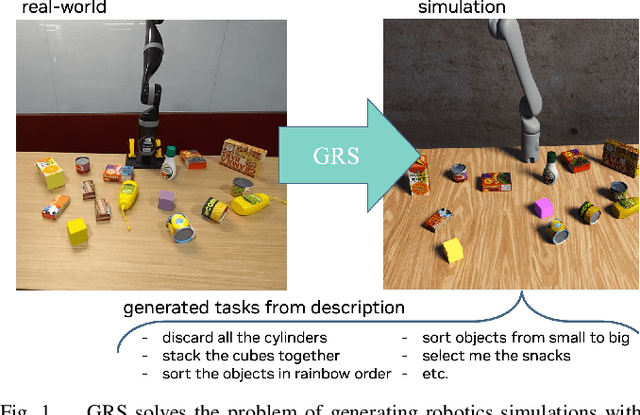
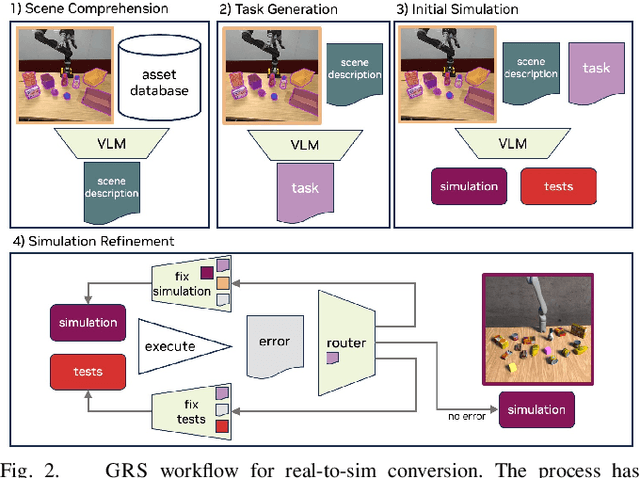
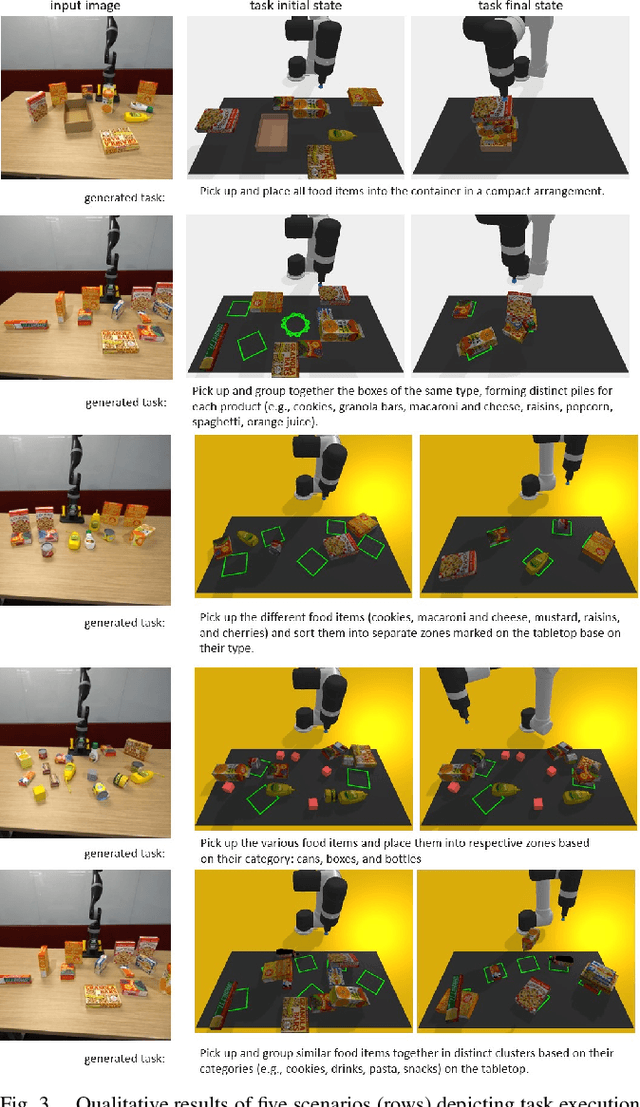
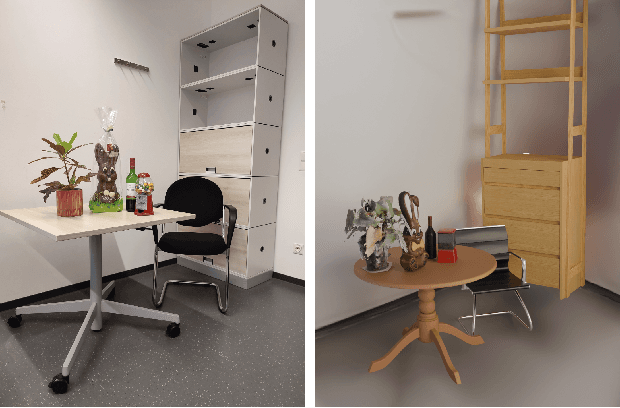
Abstract:We introduce GRS (Generating Robotic Simulation tasks), a novel system to address the challenge of real-to-sim in robotics, computer vision, and AR/VR. GRS enables the creation of digital twin simulations from single real-world RGB-D observations, complete with diverse, solvable tasks for virtual agent training. We use state-of-the-art vision-language models (VLMs) to achieve a comprehensive real-to-sim pipeline. GRS operates in three stages: 1) scene comprehension using SAM2 for object segmentation and VLMs for object description, 2) matching identified objects with simulation-ready assets, and 3) generating contextually appropriate robotic tasks. Our approach ensures simulations align with task specifications by generating test suites designed to verify adherence to the task specification. We introduce a router that iteratively refines the simulation and test code to ensure the simulation is solvable by a robot policy while remaining aligned to the task specification. Our experiments demonstrate the system's efficacy in accurately identifying object correspondence, which allows us to generate task environments that closely match input environments, and enhance automated simulation task generation through our novel router mechanism.
FactorSim: Generative Simulation via Factorized Representation
Sep 26, 2024Abstract:Generating simulations to train intelligent agents in game-playing and robotics from natural language input, from user input or task documentation, remains an open-ended challenge. Existing approaches focus on parts of this challenge, such as generating reward functions or task hyperparameters. Unlike previous work, we introduce FACTORSIM that generates full simulations in code from language input that can be used to train agents. Exploiting the structural modularity specific to coded simulations, we propose to use a factored partially observable Markov decision process representation that allows us to reduce context dependence during each step of the generation. For evaluation, we introduce a generative simulation benchmark that assesses the generated simulation code's accuracy and effectiveness in facilitating zero-shot transfers in reinforcement learning settings. We show that FACTORSIM outperforms existing methods in generating simulations regarding prompt alignment (e.g., accuracy), zero-shot transfer abilities, and human evaluation. We also demonstrate its effectiveness in generating robotic tasks.
NeRFDeformer: NeRF Transformation from a Single View via 3D Scene Flows
Jun 15, 2024Abstract:We present a method for automatically modifying a NeRF representation based on a single observation of a non-rigid transformed version of the original scene. Our method defines the transformation as a 3D flow, specifically as a weighted linear blending of rigid transformations of 3D anchor points that are defined on the surface of the scene. In order to identify anchor points, we introduce a novel correspondence algorithm that first matches RGB-based pairs, then leverages multi-view information and 3D reprojection to robustly filter false positives in two steps. We also introduce a new dataset for exploring the problem of modifying a NeRF scene through a single observation. Our dataset ( https://github.com/nerfdeformer/nerfdeformer ) contains 113 synthetic scenes leveraging 47 3D assets. We show that our proposed method outperforms NeRF editing methods as well as diffusion-based methods, and we also explore different methods for filtering correspondences.
Neural Implicit Representation for Building Digital Twins of Unknown Articulated Objects
Apr 01, 2024Abstract:We address the problem of building digital twins of unknown articulated objects from two RGBD scans of the object at different articulation states. We decompose the problem into two stages, each addressing distinct aspects. Our method first reconstructs object-level shape at each state, then recovers the underlying articulation model including part segmentation and joint articulations that associate the two states. By explicitly modeling point-level correspondences and exploiting cues from images, 3D reconstructions, and kinematics, our method yields more accurate and stable results compared to prior work. It also handles more than one movable part and does not rely on any object shape or structure priors. Project page: https://github.com/NVlabs/DigitalTwinArt
Snap-it, Tap-it, Splat-it: Tactile-Informed 3D Gaussian Splatting for Reconstructing Challenging Surfaces
Mar 29, 2024



Abstract:Touch and vision go hand in hand, mutually enhancing our ability to understand the world. From a research perspective, the problem of mixing touch and vision is underexplored and presents interesting challenges. To this end, we propose Tactile-Informed 3DGS, a novel approach that incorporates touch data (local depth maps) with multi-view vision data to achieve surface reconstruction and novel view synthesis. Our method optimises 3D Gaussian primitives to accurately model the object's geometry at points of contact. By creating a framework that decreases the transmittance at touch locations, we achieve a refined surface reconstruction, ensuring a uniformly smooth depth map. Touch is particularly useful when considering non-Lambertian objects (e.g. shiny or reflective surfaces) since contemporary methods tend to fail to reconstruct with fidelity specular highlights. By combining vision and tactile sensing, we achieve more accurate geometry reconstructions with fewer images than prior methods. We conduct evaluation on objects with glossy and reflective surfaces and demonstrate the effectiveness of our approach, offering significant improvements in reconstruction quality.
Diff-DOPE: Differentiable Deep Object Pose Estimation
Sep 30, 2023

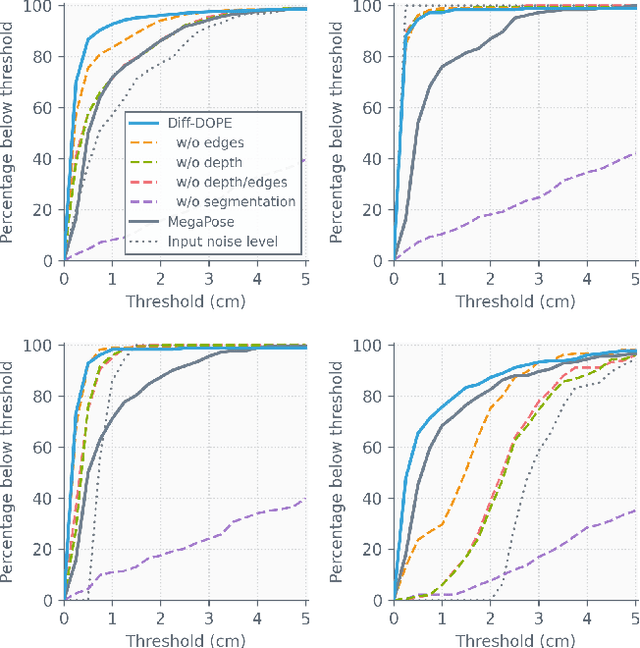

Abstract:We introduce Diff-DOPE, a 6-DoF pose refiner that takes as input an image, a 3D textured model of an object, and an initial pose of the object. The method uses differentiable rendering to update the object pose to minimize the visual error between the image and the projection of the model. We show that this simple, yet effective, idea is able to achieve state-of-the-art results on pose estimation datasets. Our approach is a departure from recent methods in which the pose refiner is a deep neural network trained on a large synthetic dataset to map inputs to refinement steps. Rather, our use of differentiable rendering allows us to avoid training altogether. Our approach performs multiple gradient descent optimizations in parallel with different random learning rates to avoid local minima from symmetric objects, similar appearances, or wrong step size. Various modalities can be used, e.g., RGB, depth, intensity edges, and object segmentation masks. We present experiments examining the effect of various choices, showing that the best results are found when the RGB image is accompanied by an object mask and depth image to guide the optimization process.
 Add to Chrome
Add to Chrome Add to Firefox
Add to Firefox Add to Edge
Add to Edge